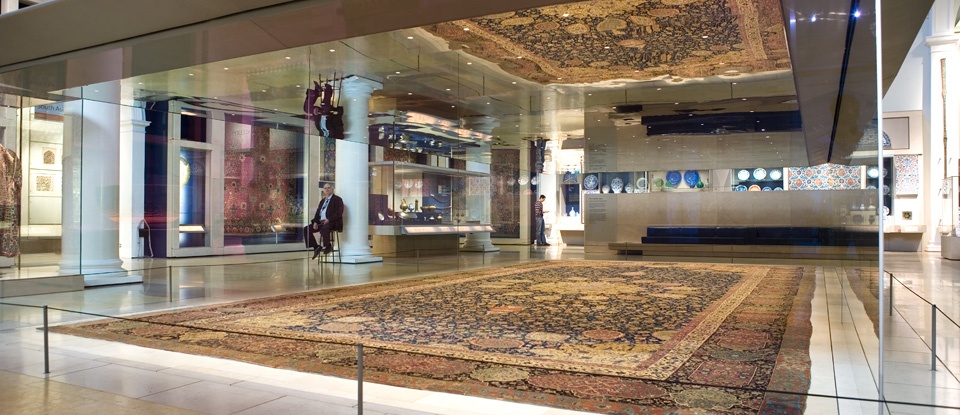Azerbaijani carpet-weaving masterpieces adorn UK museums

By Nigar Orujova
Hundreds of Azerbaijani art samples are currently available in the United Kingdom's museums, private collections and antique shops in London, Birmingham, Glasgow, Liverpool and Manchester city.
The most state-of-the-art samples are collected in Victoria and Albert (V&A), the world's greatest museum of art and design, representing over 3,000 years of human creativity, with collections unrivalled in their scope and diversity. These works, including embroidery, carpets, jewelry and pottery, are exhibited in the museum's Middle East section.
A bronze bowl dated 1,319 is the most ancient art sample among the Azerbaijani art works exhibited in the V&A.
The bowl of 7.5 centimeters in diameter and 19 cm in height with decorations made by the forging and scratching technique resembles traditional pottery bowls used until present time in Azerbaijan. The top of the bowl is covered with ornaments and Arabic script. One of the bowl's peculiarities is the depiction on it of the craftsman's name, Yusif Ahmed oglu.
Carpets are the most outstanding samples of Azerbaijani art. The Azerbaijani carpets exhibited at the museum can be divided into two groups in accordance with the characteristics of art and technology. Tabriz carpets dating back to the 16th century are in the first group, while the other group includes carpets woven in Guba-Shirvan, Ganja-Gazakh and Garabagh in the 16-19th centuries.
The Tabriz carpets themselves can be subdivided into several groups in terms of the art elements used in weaving: carpets with flowers, trees, branches, gardens, animals, and carpets describing hunting.
These carpets are amazing not only due to the antiquity and the weaving delicacy, but also their bright colors. Golden and silver yarn was used in weaving these carpets along with high quality silk and wool.
Unique Sheikh Safi carpet
Among the Tabriz carpets, the most famous carpet and one of the museum's proudest exhibits is the biggest Azerbaijani Sheikh Safi carpet, which was woven in 1539 in Tabriz for Ardabil Mosque. The carpet was made under an order of the Azerbaijani Safavid state founder Shah Ismayil Khatai's son, Tahmasib I.
Reportedly, Tahmasib sought to perpetuate his grandfather Abu Ishaq Ardabili's (known as Safi al-Din Ardabili) memory. The Sheikh was a Sufi leader who trained his followers in Islamic mystic practices.
Experts assume that the mosque, the Sheikh's tomb complex and the mentioned carpet are traced to the same place and period. The analogy between the writings and miniatures on the dome of the mausoleum and the patterns in the centre of the carpet obviously support this conclusion.
The carpet was woven by Tabriz craftsman Maqsud Kasheni, who spent two years on this piece of work. This enormous carpet was bought in Tabriz and brought to London in 1893.
The over 56 square-meter carpet with width of 5.34 meters and length of 10.51 meters is covered with painted shade flowers that are however common in color. The center of the carpet is its most magnificent part with mosaic like a flower bud. 16 red, yellow and green little circles created a colorful cupola around the bud, representing sunbeams.
However, not only the center of the carpet is breathtaking, as there are multicolored illustrations all over the rug. There is a repeating ornament of different forms called kataba, which is traditional for the South Azerbaijan carpet weaving, around the carpet edge.
The completion of the carpets is marked by a four-line inscription placed at one end. The first two lines are a poetic quote, while the third line is master Maqsud Kasheni's signature.
The fourth line contains the date 946 in the Muslim calendar, which is equivalent to 1539-1540 AD.
Another Tabriz carpet woven with golden and silver yarns is traced to the 16th century. The carpet, which is 132 cm long and 104 cm wide, describes lions, tigers, wolves and other animals, which are all in action. This makes the carpet dynamic and vivid.
Precious fabric
The V&A museum also displays Azerbaijani carpets of the 17-19th centuries made in Baku, Shamakhi, Gazakh and Garabagh regions.
The carpets, which have the illustration of herbal ornaments and storylines featuring humans, animals and birds, show the development of Azerbaijani art.
There are also weaving specimens of unique Azerbaijani art dating back to the 16-17th centuries in the V&A, most of which have a storyline.
Three of these carpets, made with silk, golden and silver yarns, attract people's attention the most. One of them illustrates a young equestrian hunting in the forest. The second one represents spring with all of its picturesque attributes, blossoming trees, and a young man with a bowl in one hand and a jar in the other.
The third fabric's plot is more comprehensive with two repeating storylines. One of them represents a person with a distinguished title sitting on the throne and a young man standing nearby with a jar in his hand. The other storyline seems to be a continuation of the first one with the same distinguished man sitting with his legs crossed in the meadow and the young man offering him a pomegranate on a plate.
Here we are to serve you with news right now. It does not cost much, but worth your attention.
Choose to support open, independent, quality journalism and subscribe on a monthly basis.
By subscribing to our online newspaper, you can have full digital access to all news, analysis, and much more.
You can also follow AzerNEWS on Twitter @AzerNewsAz or Facebook @AzerNewsNewspaper
Thank you!
